Everything you need to know about The Rugby Championship law variations

On the eve of The Rugby Championship, World Rugby has released a series of videos designed to give fans greater understanding of the law variations being implemented in the tournament.
SANZAAR confirmed this week that several law variations will be rolled out during the championship, which gets underway this Saturday when Australia host South Africa and New Zealand play Argentina.
The Rugby Championship is the first senior tournament to opt to make use of the law variations, following trials in the recent World Rugby U20 Championship and Trophy.
As part of the trial, 20-minute red cards will be used while a countdown clock will be introduced for scrums and lineouts, and the time permitted for a conversion reduced to 60 seconds.
Crooked lineout throws will not be penalised if uncontested and there will be greater protection of the scrum-half at the base of the scrum, ruck and at the maul.
“We believe this year’s championship, that has been keenly anticipated by the players and rugby fans, will again exhibit the best of what the game has to offer with exciting, tough action on the field, enhanced by the evolution in the laws of the game,” SANZAAR CEO Brendan Morris said.
“SANZAAR on behalf of its member unions continues to explore ways to make The Rugby Championship and rugby in general even more attractive to fans.”
Here is what those fans can expect to see over the next seven weeks.
Countdown clock
Under this variation, players will have 60 seconds to kick a conversion from the moment a try is scored and the same time to line up a penalty from the time the referee is informed of their intention to kick at goal.
If a player exceeds this time limit on a conversion, the kick will not count, and play will restart at the centre mark. If the time elapses during a penalty attempt, then the non-kicking team is awarded a scrum at the mark of the penalty.
Meanwhile, a scrum must be set within 30 seconds of the mark being made by the referee. A free kick will be awarded against the team causing the delay, at the place of the scrum.
A lineout must be formed within 30 seconds of the assistant referee signalling the place where the ball crossed into touch. A free kick will be awarded on the 15 metre line, against the team causing the delay.
The referee will manage the countdown clock during The Rugby Championship as there will not be a physical clock in the stadia.
Protection of the nine
In order to help the scrum-half play the ball cleanly, the ruck, maul and scrums will all be refereed differently under the law variations.
A player who was part of a ruck may not play an opponent who is within one metre of it and attempting to play the ball. The same is the case for a maul.
At scrum time, meanwhile, the scrum-half of the team not in possession “must take up a position with both feet no further than the centre line of the tunnel; or permanently retires to a point on the offside line either at that team’s hindmost foot, or permanently retires at least five metres behind the hindmost foot”.
The sanction for infringing those laws at either a scrum, maul or ruck will be a penalty.
Lineout not straight
In the event that the defending team do not lift to compete for the ball, play will continue even if the throw does not appear to have been straight.
Should the defending team contest for possession and the ball is not thrown in straight then they will be offered the option of a lineout or a scrum.
If a lineout is chosen and that throw is not straight then the team that originally threw in the ball will be awarded a scrum.
Red Cards
If an act of foul play is determined to be deliberate and carry a high level of danger then a full red card will be shown to the offending player, who will not be able to return to the pitch or be replaced.
However, all red cards that do not meet that threshold will be so-called ’20-minute red cards’.
This means that the offending player will be removed from the pitch, but they can be replaced by another player after 20 minutes.

















